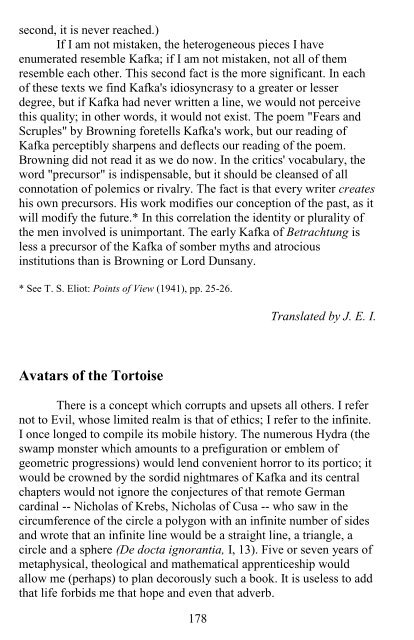Jorge Luis Borges - Labyrinths
Jorge Luis Borges - Labyrinths
Jorge Luis Borges - Labyrinths
You also want an ePaper? Increase the reach of your titles
YUMPU automatically turns print PDFs into web optimized ePapers that Google loves.
second, it is never reached.)<br />
If I am not mistaken, the heterogeneous pieces I have<br />
enumerated resemble Kafka; if I am not mistaken, not all of them<br />
resemble each other. This second fact is the more significant. In each<br />
of these texts we find Kafka's idiosyncrasy to a greater or lesser<br />
degree, but if Kafka had never written a line, we would not perceive<br />
this quality; in other words, it would not exist. The poem "Fears and<br />
Scruples" by Browning foretells Kafka's work, but our reading of<br />
Kafka perceptibly sharpens and deflects our reading of the poem.<br />
Browning did not read it as we do now. In the critics' vocabulary, the<br />
word "precursor" is indispensable, but it should be cleansed of all<br />
connotation of polemics or rivalry. The fact is that every writer creates<br />
his own precursors. His work modifies our conception of the past, as it<br />
will modify the future.* In this correlation the identity or plurality of<br />
the men involved is unimportant. The early Kafka of Betrachtung is<br />
less a precursor of the Kafka of somber myths and atrocious<br />
institutions than is Browning or Lord Dunsany.<br />
* See T. S. Eliot: Points of View (1941), pp. 25-26.<br />
Translated by J. E. I.<br />
Avatars of the Tortoise<br />
There is a concept which corrupts and upsets all others. I refer<br />
not to Evil, whose limited realm is that of ethics; I refer to the infinite.<br />
I once longed to compile its mobile history. The numerous Hydra (the<br />
swamp monster which amounts to a prefiguration or emblem of<br />
geometric progressions) would lend convenient horror to its portico; it<br />
would be crowned by the sordid nightmares of Kafka and its central<br />
chapters would not ignore the conjectures of that remote German<br />
cardinal -- Nicholas of Krebs, Nicholas of Cusa -- who saw in the<br />
circumference of the circle a polygon with an infinite number of sides<br />
and wrote that an infinite line would be a straight line, a triangle, a<br />
circle and a sphere (De docta ignorantia, I, 13). Five or seven years of<br />
metaphysical, theological and mathematical apprenticeship would<br />
allow me (perhaps) to plan decorously such a book. It is useless to add<br />
that life forbids me that hope and even that adverb.<br />
178


